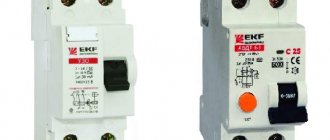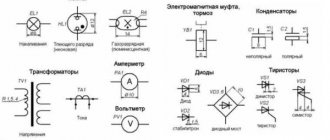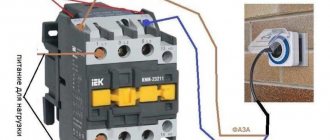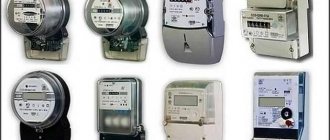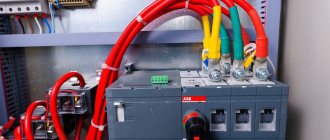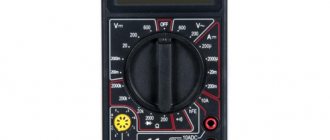Protection against electric shock using a differential circuit breaker
Modern society is characterized by the widespread use of a variety of electrical equipment. There are often cases when newly purchased equipment is connected to wiring that is not designed for high current consumption.
Another situation: instead of expensive devices from well-known manufacturers, in order to save money, designs from little-known brands are purchased. Unscrupulous manufacturers reduce the cost of products to the detriment of quality. In order to increase human safety and prevent fires, a variety of protection devices have been developed.
What is a differential automatic and what is it for?
The differential circuit breaker structurally combines two types of protection in a single housing:
- From overload (short circuit, exceeding the permissible value of current consumption);
- From leakage currents.
The first type is used in automatic circuit breakers and provides for disconnecting the phase and neutral conductors when the load current increases above that for which the circuit breaker is designed. The second type of protection is used in RCDs - residual current devices. The principle of operation is to compare the currents in the neutral and phase wires. The presence of a difference indicates the appearance of a leakage current, which can be dangerous.
In fact, the difavtomat combines two devices in one housing.
Advantages and disadvantages
The difavtomat has the following advantages:
- Saving space in distribution boards due to the combination of two devices.
- Simplify installation and reduce the number of wire connection points.
- If triggered, all supply conductors (zero and phase) are opened simultaneously.
At the same time, these devices also have disadvantages:
- Higher cost.
- Difficulty in diagnosing the cause of the trigger.
- When damaged, it changes completely, regardless of what type of protection has failed.
Thus, if with separately installed circuit breakers and RCDs it is possible to easily determine what caused the operation (short circuit or leakage current) and, if necessary, replace the necessary device, then the differential circuit breaker is changed entirely. Moreover, some skills are required to find the reasons.
Application area
The difavtomat, like the RCD, best reveals its advantages when installed in circuits that require special control. This is a powerful load, located in rooms with high danger, the presence of equipment sensitive to the parameters of the power supply network.
Dangerous areas include those with high humidity and the presence of electrical equipment. For example, a bathroom with an electric boiler or washing machine, a kitchen with an electric stove.
Comparison of differential automatic machines from 6 manufacturers with each other
Home » Tips for an electrician » Comparison of differential automatic machines from 6 manufacturers with each other
In recent years, many brands of automatic machines have appeared on the market, because of this, on forums there are constantly discussions like “which is better - Hager or ABB?”
Over the five years of work, I have had to deal with both some and others. Of all the differentials that I came across over the past year (Hager, Legrand, General Electric, ABB, Schneider, IEK), I formed my own mini-rating.
I specifically included Chinese IEK diffs in the list of European brands. In my opinion, this is a worthy alternative to famous Europeans for two reasons
- relatively good quality. “Iekovsky” difavtomats are an example of “good China”;
- and the cost is lower than that of European analogues.
What exactly are we going to compare?
I don’t see the point in making a price comparison, since it will lose relevance the next day - prices change constantly.
You can do this yourself, using the catalog with all differential machines on the AxiomPlus website, like me. There are plenty of them there...
For comparison, I took the most significant criteria:
- type of release - it determines the reliability of the automatic device;
- design and arrangement of clamp terminals - ease of installation and quality;
- case material - strength and heat resistance (at peak loads, modular automation heats up at the contact junctions);
- the presence and location of a color indicator and identification window - ease of maintenance;
- other features inherent to a particular brand or series.
Hager - a “purely German” classic
Traditional gray body with blue branding stripe. Convenient design and arrangement of clamp terminals, which facilitates installation.
The color indicator of the contact status is located in the middle of the front panel and is clearly visible through the slot in the shield, which greatly simplifies maintenance.
Pros:
- Reliable clamp terminals - the textured surface of the contact clamps ensures a good connection of conductors even without lugs;
- Durable housing with a wide button, convenient for switching and sealing;
Minuses:
- The location of the window with the inscription is inconvenient - under the button it is difficult to see through the opening. If the automatic valve works, you will have to open the door to see exactly where the leak occurred.
Legrand - simple and reliable
A distinctive feature of the case is its increased height, which provides good heat dissipation. The buttons and display window are on a flat platform and located at a convenient distance, which makes servicing more comfortable.
A large display window is located at the top and is clearly visible through the slot in the shield.
Pros:
- Simple, intuitive front panel;
- Double color indication, if the button is secured with a seal, the mechanism will still react to a leak and the color will change;
- Ribbed terminal strips ensure good wire connection.
Minuses:
General Electric - time-tested quality
A classic case with a non-standard Testa shape located at the top left. The reliable electromechanical release is more resistant to overheating.
Pros:
- High-quality durable plastic, does not collapse under the influence of temperature and mechanical stress;
- Convenient switch, thanks to the wide handle it is easy to turn;
- Twin handles that simultaneously break both phase and neutral, which provides additional insurance when triggered.
Minuses:
- Lack of color indicator - if the switches are fixed, it is impossible to understand whether the differential protection has worked;
- Lack of identification window, which causes difficulties in large main switchboards with line designation;
- When the difavtomat is placed tightly with other modules, it is difficult to pull the sealing cable through the handles.
ABB - the most popular and most counterfeited
The specific shape of the front panel with a characteristic red line and a convex plug on the left is an ABB feature.
Due to the fact that the clamp terminals are located on the right side, the connection of the groups can only be done with jumpers or special comb busbars produced only by ABB, which complicates installation.
When assembling an electrical panel in a one-room apartment, where there are a maximum of two differentials, a comb is not needed at all, but in a three-room apartment with a panel for 4-5 differentials, a comb bus can significantly simplify the task.
Pros:
- Twin buttons, like General Electric;
- Double color indication - if the button is locked, the differential protection will still work, as indicated by an independent indicator;
- The Test is conveniently located just above the plug, so you can press it without fear of touching the handle.
Minuses:
- In the DS951 series, the clamp terminals are on the right side, which causes inconvenience during installation;
- Lack of identification window, similar to General Electric;
- A large number of fakes on the market.
Schneider - a choice for any suitable price
Diffautomatic machines are presented in three series at once, so I will dwell in more detail on each of them:
- Acti9 - distinguished by a yellow latch and hemispherical protrusions near the buttons. The best differentials in the range of this manufacturer, therefore their cost is higher than others;
- Easy9 is a mid-price series. Optimal location of the Test and Power buttons, characteristic black. There is no color indicator, which makes maintenance inconvenient after sealing the switch (without removing the seal, it is impossible to find out whether the differential protection has worked). Unlike other series, this one has clamping terminals located on different sides, which makes installation easier;
- Domovoy is a budget line produced in Bulgaria for the CIS market. Features a distinctive orange wide button. To the left of it there is a color indication independent of the switch position. Like the Acti9, the clamp terminals are located on one side.
Pros:
- Large range of differentials in different price segments;
- Durable housing made of high-quality plastic that can withstand mechanical and temperature loads.
Minuses:
- In Acti9 and Easy9 - contact clamps on one side;
- Lack of identification window;
- Lack of independent color indication (except for the Brownie series).
The guys from AxiomPlus explained one important drawback: single-module Schneider (Brownie) diffs have a simplified design. (In any case, the Europeans can’t do anything bad, but the classic design is still more reliable).
In order to fit the electromechanical release into one module, the manufacturer had to reduce its size.
This means that an additional microcircuit and amplifier are installed inside, which can be damaged by temperature loads - a lower degree of reliability than classic analogs with two modules.
IEK is a cheap but high-quality analogue
For domestic use, this manufacturer presents two series:
- RCBO - on the left side of the body there is a characteristic yellow switch, and below it there is a color indication. Small but easy to press gray Test button;
- AD1 - outwardly differs little from RCBOs, with the exception of paired switches that “break” the phase and neutral at the same time. The color indication is located on top of the switches. There are additional holes for the comb, which simplifies installation.
Where is it better to install a difavtomat instead of an RCD?
Considering that a differential circuit breaker takes up less space than jointly installed current circuit breakers and RCDs, they are most convenient when placed in small-sized distribution boards. It is also convenient to use difavtomats in panels that distribute power to a large number of circuits, since this can significantly simplify the load. At the same time, reliability increases, since the weak points in distribution boards are the switching points - the terminals of devices with connected wires.
Options
When installing a difavtomat, three main parameters should be taken into account:
- Supply voltage and number of phases – 220V or 380V, 1 phase or 3.
- Operation current. This parameter is similar to that of the circuit breaker.
- Leakage current. Everything here is similar to an RCD.
There are a few more parameters that not everyone is familiar with:
- Rated breaking capacity. Short circuit current that the device can withstand without malfunctioning.
- Response time of differential protection.
- Current limiting class. Shows the time it takes to extinguish the electric arc during a short circuit.
- The type of electromagnetic release on which the excess of the operating current compared to the rated one depends.
Type of electromagnetic release
The electromagnetic release in the automatic circuit breaker is designed to instantly open the circuit when the rated current is exceeded by a specified number of times. The following types are common:
- B – the operating current exceeds the rated current by 3-5 times.
- C – operation current exceeds the rated current by 5-10 times.
- D – operation current exceeds the rated current by 10-20 times.
Leakage current (disconnecting differential current) and its class
The sensitivity threshold of the differential transformer determines the leakage current, which triggers the protection. The most widespread are differential transformers with a sensitivity of 10 and 30 mA.
In addition to the numerical value of the leakage current, the shape is important. In accordance with this, the following classes of protection devices are distinguished:
- AC – sinusoidal leakage current is controlled.
- A - in addition to sinusoidal, a pulsating constant is taken into account, which is important when protecting digital electronic equipment.
- B – a smoothed constant is added to the listed currents.
- S – shutdown time delay – 200-300 ms.
- G – time delay – 60-80 ms.
Rated breaking capacity and current limiting class
This parameter characterizes the short circuit current that the contact group of the circuit breaker is able to withstand without damage during the shutdown time. The higher the value of the parameter, the greater the likelihood that after eliminating the damage in the network, the difavtomat will remain operational. A typical range of values is:
- 3000 A;
- 4500 A - together with the first value, is practically not used today;
- 6000 A is a frequently used value;
- 10000 A - suitable for places close to the power substation, but has a high cost.
The current limiting class characterizes the shutdown speed when a critical current flows. The switch-off time (speed) includes the arc extinguishing time between the breaking contacts. Less time, i.e. higher shutdown speed, guarantees greater safety. There are three classes: from first to third.
Electronic or electromechanical
Based on internal equipment, electromechanical and electronic devices are distinguished. Electromechanical automatic machines are considered more reliable and do not require external power to operate.
Electronic devices have more stable parameters, but for normal operation they require stable power at the input.
Selective type operating principle
In branched electrical networks, a two-level protection system is used.
At the first level, a differential automatic machine is installed that controls the load line completely. On the second, difavtomats control each selected circuit separately.
To prevent the simultaneous operation of protection devices of both levels, the first differential circuit breaker must have selectivity, which is determined by the shutdown delay time. For these purposes, machines of classes S or G are used.
Purpose, technical characteristics and selection
The differential circuit breaker or differential circuit breaker combines the functions of a circuit breaker and an RCD. That is, this one device protects the wiring from overloads, short circuits and leakage current. Leakage current is formed when the insulation is faulty or when touching live elements, that is, it still protects a person from electric shock.
Difavtomats are installed in electrical distribution panels, most often on DIN rails. They are installed instead of the automatic + RCD combination, and physically take up a little less space. How specific depends on the manufacturer and type of execution. And this is their main advantage, which can be in demand when upgrading the network, when space in the panel is limited and it is necessary to connect a certain number of new lines.
Difavtomats are used to protect wiring from increased loads and people from electric shock.
The second positive point is cost savings. As a rule, a difavtomat costs less than a pair of automatic and RCD with similar characteristics. Another positive point is that you only need to decide on the rating of the circuit breaker, and the RCD is built in by default with the required characteristics.
There are also disadvantages: when one of the parts of the difavtomat is released and built, the entire device will have to be changed, and this is more expensive. Also, not all models are equipped with flags that can be used to determine why the device worked - due to overload or leakage current - which is fundamentally important when determining the reasons.
Characteristics and selection
Since the difavtomat combines two devices, it has the characteristics of both of them and everything must be taken into account when choosing. Let's figure out what these characteristics mean and how to choose a differential machine.
Designation of difavtomats on diagrams
Rated current
This is the maximum current that the machine can withstand for a long time without loss of performance. It is usually indicated on the front panel. Rated currents are standardized and can be 6 A, 10 A, 16 A, 20 A, 25 A, 32 A, 40 A, 50 A, 63 A.
Four-pole automatic circuit breaker for connection to a 380 V network
Small ratings - 10 A and 16 A - are placed on lighting lines, medium ratings - on powerful consumers and socket groups, and powerful ratings - 40 A and above - are mainly used as an introductory (general) circuit breaker. It is selected depending on the cable cross-section, in the same way as when choosing the rating of a circuit breaker.
Time-current characteristic or type of electromagnetic release
Displayed next to the rating, denoted by the Latin letters B, C, D. Indicates at what overload relative to the rating the machine is turned off (to ignore short-term starting currents).
Rating of the automatic circuit breaker and its time-current characteristics
Category B - if the current is exceeded by 3-5 times, C - if the current is exceeded by 5-10 times, type D is turned off at loads that exceed the rating by 10-20 times. In apartments they usually install difavtomats of type C, in rural areas they can install B, in enterprises with powerful equipment and large starting currents - D.
Rated voltage and frequency
What networks is the device intended for - 220 V and 380 V, with a frequency of 50 Hz. There are no others in our distribution network, but still, it’s worth checking out.
Voltage and frequency for which the differential circuit breaker is designed
Differential machines can be double marked - 230/400 V. This means that this device can operate in both 220 V and 380 V networks. In three-phase networks, such devices are placed on socket groups or on individual consumers, where used just one of the phases.
As water automatic machines for three-phase networks, devices with four inputs are required, and they differ significantly in size. It is impossible to confuse them.
Rated residual current or leakage current (settings)
Displays the sensitivity of the device to the resulting leakage currents and shows under what conditions the protection will operate. In everyday life, only two ratings are used: 10 mA for installation on lines in which only one powerful device or consumer is installed, which combines two dangerous factors - electricity and water (instantaneous or storage electric water heater, hob, oven, dishwasher and etc.).
For lines with a group of sockets and outdoor lighting, difavtomats with a leakage current of 30 mA are installed; they are not usually installed on lighting lines inside the house - to save money.
Leakage current or settings on the differential machine
The device can simply have a value written in milliamps (as in the photo on the left) or a letter designation of the setting current can be applied (in the photo on the right), followed by numbers in amperes (at 10 mA it is 0.01 A, at 30 mA the number is 0 .03 A).
Differential protection class
Shows what type of leakage current this device protects against. There is a letter and graphic image. Usually they put an icon, but there can also be a letter (see the table).
| Letter designation | Graphic designation | Decoding | Application area |
| AC | Responses to alternating sinusoidal current | Placed on lines to which simple equipment without electronic control is connected | |
| A | Responses to sinusoidal alternating current and pulsating direct current | Used on lines that power electronically controlled equipment | |
| IN | Captures variable, impulse, constant and smoothed constant. | Mainly used in production with a large number of different equipment | |
| S | With a shutdown time delay of 200-300 ms | In complex circuits | |
| G | With shutdown time delay 60-80 ms | In complex circuits |
The choice of the differential protection class of the difavtomat is based on the type of load. If this is equipment with microprocessors, class A is required; for lighting or power supply lines of simple devices, class AC is suitable. Class B is rarely installed in private houses and apartments - there is no need to “catch” all types of leakage currents. Connecting class S and G circuit breakers makes sense in multi-level protection schemes. They are used as input if there are other differential shutdown devices further in the circuit. In this case, when one of the lower leakage currents is triggered, the input one will not turn off and the serviceable lines will be in operation.
Rated breaking capacity
Shows what current the automatic circuit breaker is able to turn off when a short circuit occurs and remain operational. There are several standard ratings: 3000 A, 4500 A, 6000 A, 10,000 A.
Breaking capacity of difavtomat
The choice of a difavtomat based on this parameter depends on the type of network and the range of the substation. In apartments and houses at a sufficient distance from the substation, difavtomats with a breaking capacity of 6,000 A are used; close to substations, they are installed at 10,000 A. In rural areas, when power is supplied by air and in networks that have not been modernized for a long time, 4,500 A is sufficient.
On the case this number is indicated in a square frame. The location of the inscription may vary depending on the manufacturer.
Current limiting class
For the short circuit current to reach its maximum value, some time must pass. The sooner power is removed from a damaged line, the less likely damage will occur. The current limiting class is displayed in numbers from 1 to 3. The third class - turns off the line the fastest. So choosing a difavtomat on this basis is simple - it is advisable to use devices of the third class, but they are expensive, but they remain operational longer. So, if you have the financial opportunity, install automatic machines of this class.
Current limitation of difavtomat
On the housing this characteristic is shown in a small square frame next to the rated breaking capacity. It can be on the right (for Legranda) or at the bottom (for most other manufacturers). If you did not find such a mark either on the case or in the passport, then this machine does not have a current limit.
Temperature of use
Most differential circuit breakers are designed for indoor operation. They can be operated at temperatures from -5°C to + 35°C. In this case, nothing is placed on the body.
Designation of increased frost resistance of the difavtomat
Sometimes shields are placed outdoors and ordinary protective devices will not work. For such cases, automatic machines are produced with a wider temperature range - from -25°C to +40°C. In this case, a special mark is placed on the body, which looks a little like an asterisk.
Presence of markers indicating the reason for the operation
Not all electricians like to install automatic circuit breakers, because they believe that the combination of protective circuit breaker + RCD is more reliable. The second reason is that if the device works, it is impossible to determine what caused it - an overload, and you just need to turn off some device, or a leakage current, and you need to look for where and what happened.
To solve at least the second problem, manufacturers began to make flags that show the reason for the operation of the automatic device. In some models, this is a small area, the position of which determines the reason for the shutdown.
A checkbox that shows the reason for the shutdown
If the shutdown was caused by an overload, the indicator remains flush with the body, as in the photo on the right. If the automatic circuit breaker operates in the presence of leakage current, the flag protrudes some distance from the body.
Type of design
There are two types of differential automatic machines: electromechanical or electronic. Electromechanical ones are more reliable, as they remain operational even if the power goes out. That is, if a phase fails, they can operate and also turn off the zero. Electronic ones require power to operate, which is taken from the phase wire and when a phase is lost, they lose their functionality.
Manufacturer and price
You shouldn’t skimp on electricity, especially on devices that protect wiring and life. Therefore, it is recommended to always buy components from well-known manufacturers. The leaders in the market are Legrand (Legrand) and Schneider (Schneider), Hager (Hager), but their products are expensive, and there are many fakes. The prices of IEK (IEK), ABB (ABB) are not so high, but there are also more problems with nm. In this case, it is better not to contact unknown manufacturers, as they are often simply ineffective.
The choice is actually not that small, even if you limit yourself to only these five companies. Each manufacturer has several lines that differ in price, and significantly. To understand the difference, you need to carefully look at the technical specifications. The price is affected by each and them, so carefully study all the data before purchasing.
Features of choice for an apartment or house
The parameters of the machines largely depend on the characteristics of the electrical wiring and the installed equipment. Protection with a leakage current of 30 mA is often installed, since more sensitive devices can produce false alarms when the wiring is worn out and when there are a large number of connected devices.
The type of electromagnetic release is determined by the parameters of the connected load.
The operating current is governed by the same conditions as when choosing circuit breakers.
Scheme
When designing a wiring diagram for an apartment or house, there can be many options. They may differ in ease of use, reliability of operation, and degree of protection. There are simple options that require minimal costs. They are usually implemented in small networks. For example, in dachas, in small apartments with a small number of household appliances. In most cases, it is necessary to install a large number of devices that ensure the safety of the wiring and protect people from electric shock.
Schemes come in different levels of complexity
Simple scheme
It does not always make sense to install a large number of protective devices. For example, at a dacha for a seasonal visit, where there are only a few sockets and lighting, it is enough to install only one difavtomat at the entrance, from which separate lines will go to groups of consumers - sockets and lighting - through the machines.
A simple diagram for connecting a difavtomat to a small network
This scheme will not require large expenses, but if a leakage current appears on any of the lines, the difavtomat will work, de-energizing everything. There will be no light until the causes are clarified and eliminated.
More reliable protection
As already mentioned, some automatic machines are placed on “wet” groups. These include the kitchen, bathroom, outdoor lighting, and appliances that use water (except the washing machine). This method of building a system provides a higher degree of safety and better protects wiring, equipment and people.
A more complex and reliable scheme: connecting a difavtomat to every potentially dangerous device
The implementation of this wiring method will require large material costs, but the system will operate more reliably and stably. Since when one of the protective devices is triggered, the rest will remain operational. This connection of the difavtomat is used in most apartments and small houses.
Selective schemes
In extensive power supply networks, there is a need to make the system even more complex and expensive. In this option, an input differential circuit breaker of class S or G is installed after the meter. Further, each group has its own circuit breaker, and, if necessary, they are also installed for individual consumers. See the photo below for connecting the difavtomat for this case.
Selective installation diagram of a difavtomat
With this design of the system, when one of the linear devices trips, all the others will remain in operation, since the input differential switch has a delay in response.
Errors when purchasing
The main mistake when buying a automatic rifle is the desire to protect yourself. In this connection, consumers choose devices with minimal current protection and overload. As a result, numerous false positives are observed.
Exceeding the shutdown current does not guarantee reliable shutdown at high load currents.
Competent selection of automatic protection parameters is usually carried out by specialists, who also give recommendations on the distribution of electrical circuits and the installation of a power panel. The lack of proper qualifications does not guarantee normal protection of consumers from emergency situations.
Difavtomat device and principle of operation
Greetings, dear guests and regular readers of the site https://elektrik-sam.info!
We are starting another series of publications as part of the course “Circuit breakers, RCDs and differential circuit breakers - a detailed guide”, this time dedicated to differential circuit breakers. Let's start by considering the design and operating principle of difavtomats.
Difavtomat device and principle of operation
Greetings, dear guests and regular readers of the site https://elektrik-sam.info!
We are starting another series of publications as part of the course “Circuit breakers, RCDs and differential circuit breakers - a detailed guide”, this time dedicated to differential circuit breakers. Let's start by considering the design and operating principle of difavtomats.
A residual current circuit breaker or differential current circuit breaker is a device that combines the functions of a circuit breaker and an RCD in one housing. Those. it allows you to protect the controlled circuit from overload currents and short circuit currents (circuit breaker functions) and from leakage currents (RCD functions), allowing you to protect a person from possible electric shock and prevent the possibility of fire as a result of violation of the insulation of live parts of the electrical installation.
Structurally, difavtomats are made of dielectric material and have a latch for installation on a DIN rail. Installation is carried out in the same way as installing an RCD.
For a single-phase 220V network, two-pole difavtomats . The phase and neutral conductors of the power supply network are connected to the terminals of the upper poles, and the phase and neutral conductors from the load are connected to the terminals of the lower poles. At the same time, depending on the manufacturer’s brand and series, they can occupy either two or more modules for installation on a DIN rail.
For a three-phase 380V network, four-pole difautomats . Three phase wires and zero on the power side are connected to the upper terminals. There are three phase wires and zero from the load to the lower terminals.
When installed on a DIN rail, four-pole breakers take up the space of more than four modules, depending on the manufacturer's brand. Those. There are four poles for connecting wires, and the space occupied in the electrical panel is more than four modules, due to the differential protection unit.
The use of two-pole breakers, which, when installed, occupy two modules, allows you to save space in the electrical panel and simplify installation, instead of a separately installed circuit breaker and RCD (which together occupy three modules).
Appearance
Externally, the three-phase automatic circuit breaker is a housing made of heat-resistant plastic with eight screw terminals to which the supply wires are connected (on top of the housing) and the wires to which the load is connected (from the bottom). A diagram of the internal structure is applied to the case.
Structurally, a three-phase differential circuit breaker is a device that combines a three-phase differential relay and a three-phase circuit breaker in one housing. It is usually mounted on a standard 35 mm DIN rail and can occupy 6-7 modules.
Three-phase automatic machines
Reliable three-phase automatic circuit breaker
is a device for ensuring the safety of electrical networks that are laid in industrial enterprises, office premises, municipal institutions and private homes. Its installation allows you to solve two problems at once. The first is to protect against short circuits, and the second is to ensure the safety of the health of people and pets. To select such a protective device, its characteristics should be identified in advance.
In our company you can use a three-phase differential automatic machine
, designed to solve a number of problems. Firstly, you save space for installing switchboard systems. The fact is that without it you will have to install a circuit breaker and an RCD. Secondly, thanks to it, you will achieve the most effective protection of electrical equipment, and your own home, from short circuits and power overloads. In order to correctly select and buy a 3-phase automatic circuit breaker, you should know the rated voltage and phase of the electrical network. In addition, the current rating parameter is important. We provide a guarantee for all products sold by our company.
- View as
- Table
- List
The differential circuit breaker AD-2(4)(S) of the EKF PROxima series is a device that combines the functions of a circuit breaker with a residual current device. When a circuit breaker detects a leakage current (damage) to the ground or an overcurrent (overload current or short circuit) in the protected section of the network, the device is triggered, leading to the shutdown of the protected network.
The differential circuit breaker AD-32 of the EKF PROxima series is a device that combines the functions of a circuit breaker with a residual current device. When a circuit breaker detects a leakage current (damage) to the ground or an overcurrent (overload current or short circuit) in the protected section of the network, the device is triggered, leading to the shutdown of the protected network. A special difference between EKF differential circuit breakers is that they are available.
The differential circuit breaker AD-2(4)(S) of the EKF PROxima series is a device that combines the functions of a circuit breaker with a residual current device. When a circuit breaker detects a leakage current (damage) to the ground or an overcurrent (overload current or short circuit) in the protected section of the network, the device is triggered, leading to the shutdown of the protected network.
The differential circuit breaker AD-32 of the EKF PROxima series is a device that combines the functions of a circuit breaker with a residual current device. When a circuit breaker detects a leakage current (damage) to the ground or an overcurrent (overload current or short circuit) in the protected section of the network, the device is triggered, leading to the shutdown of the protected network. A special difference between EKF differential circuit breakers is that they are available.
The differential circuit breaker AD-32 of the EKF PROxima series is a device that combines the functions of a circuit breaker with a residual current device. When a circuit breaker detects a leakage current (damage) to the ground or an overcurrent (overload current or short circuit) in the protected section of the network, the device is triggered, leading to the shutdown of the protected network. A special difference between EKF differential circuit breakers is that they are available.
The differential circuit breaker AD-2(4)(S) of the EKF PROxima series is a device that combines the functions of a circuit breaker with a residual current device. When a circuit breaker detects a leakage current (damage) to the ground or an overcurrent (overload current or short circuit) in the protected section of the network, the device is triggered, leading to the shutdown of the protected network.
The differential circuit breaker AD-2(4)(S) of the EKF PROxima series is a device that combines the functions of a circuit breaker with a residual current device. When a circuit breaker detects a leakage current (damage) to the ground or an overcurrent (overload current or short circuit) in the protected section of the network, the device is triggered, leading to the shutdown of the protected network.
Purpose and application
The difavtomat must be used in conditions where involuntary mechanical damage to the insulation of conductors or breakdown due to high humidity is possible, that is, when there is a risk of electric shock to humans or animals.
In practice, these can be places where a large number of people stay (concert halls, shopping malls), premises for breeding and keeping animals, swimming pools, baths, Jacuzzi baths, production workshops.
Electrical installation rules recommend the use of differential circuit breakers in other cases where increased safety requirements are required.
It is obvious that at electrical facilities powered by a three-phase alternating current network, it is necessary to use a three-phase automatic circuit breaker.
A difavtomat is a device that combines two others in its design - a circuit breaker and a differential relay or residual current device (RCD).
These two devices are completely different both in design and operating principle. Replacing one with the other is unacceptable. Sometimes the cost of a three-phase automatic circuit breaker is more expensive than the RCD and circuit breaker combined. In this case, the owner decides that it is better to install it on a three-phase network.
Connection diagram for difavtomat
In the latest edition of the rules for the operation of electrical installations, measures to protect people from electric shock are placed in first place, and only in second place are technical devices. Therefore, the installation of an RCD (residual current device) today is a mandatory requirement when constructing electrical circuits.
At the same time, no one has canceled the requirement to install circuit breakers that protect against overcurrents (short circuits) and heating due to overload. You can combine one with the other by installing an automatic residual current switch (RCCB), colloquially called a “difavtomat”. Its use makes it possible to simplify the circuit - instead of two devices, one is installed, and the installation process. Today we will talk about how to properly connect a difavtomat and about typical mistakes made.
How to connect a difavtomat
Let's start with installation methods and the order of connecting conductors. Everything is very simple, there are no special difficulties. In most cases, it is mounted on a dinrail. To do this, there are special protrusions that hold the device in place.
Dinrail mount
Electrical connection
The difavtomat is connected to the electrical network using insulated wires. The cross section is selected based on the nominal value. Usually the line (power supply) is connected to the upper sockets - they are signed with odd numbers, the load - to the lower ones - signed with even numbers. Since both phase and zero are connected to the differential machine, so as not to confuse it, the sockets for “zero” are labeled with the Latin letter N.
The connection diagram for the difavtomat is usually on the case
In some lines you can connect the line to both the upper and lower sockets. An example of such a device is in the photo above (left). In this case, numbering is written on the diagram through a fraction - 1/2 at the top and 2/1 at the bottom, 3/4 at the top and 4/3 at the bottom. This means that it does not matter whether the line is connected from above or below.
Connecting the difavtomat on the distribution panel
Before connecting the line, remove the insulation from the wires at a distance of approximately 8-10 mm from the edge. At the desired terminal, slightly loosen the fixing screw, insert the conductor, and tighten the screw with sufficient force. THEN the wire is pulled several times to make sure that the contact is normal.
Functionality check
After you have connected the difavtomat and supplied power, you need to check the functionality of the system and the correct installation. First, let's test the unit itself. There is a special button for this, labeled “Test” or simply the letter T. After we have switched the switches to working condition, press this button. In this case, the device should “knock out”. This button artificially creates a leakage current, so we checked the operation of the difavtomat. If there was no operation, you need to check the correct connection; if everything is correct, the device is faulty
If the automatic machine works when you press the “T” button, it is operational
Further testing is to connect a simple load to each outlet. This will check that the socket groups are connected correctly. And the last thing is the alternate switching on of household appliances, which have separate power lines.
RCBO - outside and inside
External differences between RCBOs and automatic machines and RCDs:
- Unlike a circuit breaker, a difavtomat is never single-pole. There are two connection points in a single-phase network, but in a three-phase network there are always four.
The electrical circuit on the front panel of the device contains three mnemonic symbols:- An oval enclosing the conductors at the input. This is the toroidal core of a differential transformer.
- A half-circle arc on a phase line, indicating an electromagnetic release.
- A rectangular protrusion on the phase line is a thermal relay.
The RCD does not have an electromagnetic release symbol, and the circuit breaker does not have a differential transformer symbol.
- The mains current rating of the RCBO, unlike the RCD, has an additional letter designation - A, B, C or D, indicating its time-current characteristic.
There are three sensitive elements inside the difavtomat:
- Electromagnetic release.
- Thermal release.
- Residual current meter.
The solenoid of the electromagnetic release is connected not only to the phase line, but also to the differential transformer. Since the current produced by the meter is small - depending on the model, it can be in the range from 6 to 500 mA, an amplifier is included in the circuit.
You can read more about the differences between RCD and difavtomat here.
Principle of operation
Inside the three-phase automatic machine there is a transformer, the coils of which are wound on a toroidal core. When winding the coils, four pieces of wire are used - 3 phases and zero.
When a load is connected, magnetic fluxes arise from the phase and neutral wires in the transformer. In the absence of leakage, the total current in the phase conductors is equal to the current in the neutral conductor, but opposite in value.
Ia+Ib+Ic-In=0
As a result, the total magnetic flux of the transformer is zero. If a leakage current occurs in the circuit in at least one of the wires, a magnetic flux appears and, acting on the winding of the electromagnetic relay, causes it to operate. As a result, the three-phase automatic circuit breaker is switched off.
In the event of overcurrents occurring in the circuit, in the absence of a leak, the difavtomat turns off when the contact free release mechanism is activated. This mechanism can be activated by a thermal or electromagnetic release.
The thermal release contains a bimetallic plate in its design, which heats up when a current of a given value occurs and, changing the geometry, affects the mechanism.
The electromagnetic release consists of a solenoid coil, the core of which is drawn into the housing when the current value in any of the phase wires increases, and at a certain moment the mechanism is triggered.
Connecting the automatic machine
Connecting a difavtomat in a single-phase network simply consists of the correct connection of the phase and zero (neutral) lines at the input and output. It is very difficult to confuse them: the phase input is indicated by the number one, and the neutral - by the Latin letter N. And it usually says “Network”. The output phase terminal is marked with the number 2, and the neutral terminal with the letter N. There is also the inscription “Load”.
The connection diagram for a differential circuit breaker in a single-phase electrical network without an additional protective conductor is shown in the figure below.
Isn’t it all extremely simple and clear? Difficulties and errors most often occur when working with circuits that have a protective conductor.
Installation
The rules for installing a difavtomat in a three-phase network are the same as in a single-phase network, only the number of phase wires is increased.
A three-phase difavtomat is installed immediately before the load consuming three-phase current, or at the entrance to an electrical installation in which the load is distributed across phases after the difavtomat.
The main condition for the correct operation of a three-phase automatic circuit breaker is the inadmissibility of installing it in circuits in which the neutral conductor is connected to the grounding conductor.
Before installation, the device body must be inspected to ensure there are no cracks or other obvious defects. Installation is carried out after first turning off the mains voltage.
The difavtomat is fixed on the rail, the insulation of the connecting wires is stripped and they are connected to the connectors according to the diagram. The input wires must come from the top. After this, apply voltage and check how the electrical network works. This completes the installation.
